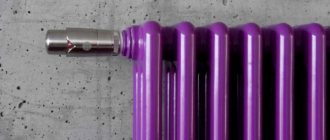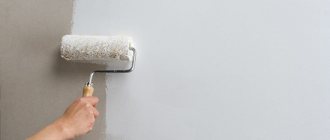For acrylic paint roller
Many people buy expensive materials for repairs, but completely forget that the application tools are also important. Therefore, saving on them is not entirely the right decision. The smoothness and uniformity of the coating will depend on what you use to apply the paint. Cheap brushes leave streaks and unevenness behind, so it's best to use a roller. Find out which roller is best for acrylic or other types of paint, and what material it should be made of, from our article.
Choosing the width and diameter of the roller for acrylic paint
If your choice is acrylic, the length and material of the tool must be selected more carefully. Why do most masters advise choosing a roller? The main reasons are:
- quick application to the surface;
- does not leave stains or streaks;
- blends paint perfectly;
- The acrylic composition can be applied to any surface;
- painting a large area with acrylic or any other liquid;
- you can create various effects: orange peel, notches, bulges.
The roller for acrylic paint should depend on the volume of the surface to be painted. In general, manufacturers create instruments of various sizes: from 5 to 40 cm in diameter. When choosing a device, you need to be guided only by this rule: the larger the surface area you are going to process, the wider and larger the device should be. If you need to paint the ceiling, you should choose a device no more than 30 cm wide, since a larger tool will cause inconvenience.
And also, we must not forget about the extension cord for the handle. It is extremely inconvenient to work on a chair, so it is necessary to purchase such a device. The length of the handle should reach 30 or 40 cm.
Important! When purchasing repair tools, you cannot limit yourself to just one roller. There are hard-to-reach places on the walls that can only be painted with a brush. You should purchase several brushes of different types at once. These should be oblique, curved and radiator brushes.
Features of choosing a fur coat
When purchasing repair equipment, you should pay special attention to the material from which the roller is made. After working with some tools, lint, hair and other unwanted things may remain on the wall. Therefore, you need to know how to work with these devices and what paints they are suitable for.
Foam rubber
Foam rubber is least suitable for applying acrylic paint. Only a true specialist can use such a roller, but a beginner will have to suffer. This material, unfortunately, is short-lived and quickly absorbs liquid, which is not economical. It is inconvenient to use this device for painting, as the paint drips copiously onto the floor.
Important! Craftsmen do not recommend using foam rubber devices for painting with aggressive paints or other liquids - enamel or an oil mixture. These liquids corrode the foam rubber, which remains on the wall in the form of small pieces. In addition, it leaves bubbles and streaks on the wall.
Pile, fur
Using a pile, you can apply any paint or other composition to the wall. When purchasing such a tool, you need to pay attention to the length of the bristles. A device with medium pile is excellent for applying water-based composition. If you need to apply a thick layer of acrylic to the wall, you should purchase a device with long pile, as such a roller absorbs more of the composition. But you need to take into account that working with such a tool is much harder, because the muscles of the hands will tense under the weight of the soaked bristles and then ache. Experts recommend buying a roller with medium pile - this is a universal product for painting any walls. If you need a thin layer of paint, you need to purchase a device with short pile. The minimum length of the pile reaches 5 mm, and the maximum is 26 mm.
A fur roller is perfect for applying oil compositions or enamel. When painting, it is tedious to take into account that lint and hairs can remain on the wall and create defects.
Important! If you choose a lint device, you should soak it for 3 or 4 hours before use. This way you can achieve maximum rigidity of the fibers, which is extremely important for the uniform application of acrylic or any other composition.
Velours
Velor is suitable for applying aggressive liquids and solvents. This device can be used to cover any surface. This is a universal remedy that has virtually no drawbacks. The only downside is that velor absorbs liquid very quickly, so you will have to dip it into the composition much more often.
Polyamide
Professional painters often choose a polyamide roller or a lint tool. It is quite difficult to use in work, since the acrylic composition is absorbed quickly and spreads over the walls. But this is a long-lasting device that can be used to apply any composition to all surfaces known to us. This tool must be used very carefully to avoid splashing liquid, so it is not recommended for beginners. This device is also great for applying acrylic composition.
We must not forget that the device must be washed with a solution after use: this way it can be used many times.
Types of paints
The following paints are suitable for painting the ceiling surface:
You can choose paint to suit every taste
Water-based ceiling paint
This type of paint is most often used for painting ceilings and other surfaces. Sometimes people wonder if water-based paint is harmful for residential premises? We can assure you that it is absolutely safe, because the dyes in it are diluted on a water basis, this makes them completely non-toxic (there are no other solvents).
This paint has high fire safety. It’s not for nothing that water-based paint is used almost everywhere (see Ceiling paint: selection criteria). They paint rooms in kindergartens, schools, hospitals and other institutions. I think the choice in favor of water-based paint is obvious.
What is the best paint to paint the ceiling?
Acrylic paint
One of the most popular paints for applying to the ceiling surface is acrylic paint.
- It has exceptional moisture and wear-resistant properties. This allows you to regularly clean it from contamination using detergents.
- Resistant to direct sunlight, acrylic paint does not fade. Easily repairs small cracks in ceiling putty.
- It dries quite quickly and does not have an unpleasant odor.
- In hardware stores you will find a variety of acrylic paints in a wide variety of colors (see Paint for ceilings and walls). Each manufacturer presents on the market at least several items in this direction, with different paint characteristics.
When choosing paint for painting the ceiling, keep in mind that if you give preference to white, you will have to wash it out often.
Silicate paint
It is used for painting mineral surfaces, since it itself consists of liquid glass. It is not suitable for application to polymer coatings, which makes its use for painting the ceiling surface an almost impossible task. Has significantly less elasticity than acrylic paints
Silicate paint
Silicone paint
We can say that the most suitable paint for the ceiling is silicone, if not for its high cost.
Combines all the best in mineral and organic coatings. Good elasticity allows you to close cracks with a thickness of 2 mm. Excellent vapor permeability and at the same time water-repellent properties allow the ceiling to “breathe” and the surface not to become dirty. Fresh paint has virtually no odor. Silicone resin prolongs the durability of the paint and prevents the development of any fungi .
Silicone paint
Which roller is better?
Different types of tools should be selected for different surfaces. Let's figure out which roller to paint the ceiling with, and which one is more convenient to paint concrete walls or wallpaper.
Paint the ceiling
Usually, water-based or acrylic paints are used to paint the ceiling, so let’s figure out first which roller is better for painting with water-based paint.
Water-based dispersion paints and water-based paints are best applied with a fur-lined tool. The length of the fibers must be selected from 12 mm. Considering that paint needs to be applied from below and the paint composition tends to fall to the floor, workers have to ensure a supply of paint in the tool to prevent skips. It is the long and medium pile that will ensure uniform coloring of the entire surface of the ceiling without streaks.
When painting the ceiling with a roller, you need to pay attention to one more characteristic - the width of the working part. The ceiling surface is most often a large, flat space, and therefore, to paint it, choose rollers of large width - at least 250 mm. The same applies to the diameter; the larger the diameter of the roller, the faster and easier it is to apply paint to the ceiling.
Painting the ceiling from a stepladder or trestle is not always convenient and safe, so for such work you need to select rollers with a long or telescopic handle. In this way, you can paint the ceiling without using a height, i.e. straight from the floor. In addition, this position of the technician allows you to quickly identify unevenness of the coating and correct deficiencies.
To paint walls
The choice of which roller is best to paint walls depends on the texture and material of the base, as well as the type of paint:
- if you are going to paint wooden walls with water-based paint, a medium-width roller with foam rubber will do;
- for processing smooth concrete surfaces, it is better to choose fur rollers with medium-sized bristles or skins made of polyamide threads;
- textured images are applied to the walls using rollers with an elastic rubberized or foam base;
- Velor skins are considered universal roller skins, suitable for painting walls with any paint composition.
Paint wallpaper
To figure out which roller to choose for painting wallpaper, you need to understand that wallpaper to be painted usually has a relief pattern, so it is important to paint the texture to its full depth. The choice should be made on rollers with fur or velor skin and medium pile. If the depth of the relief on the wallpaper is large, choose a pile from 18 mm.
Technology of painting the ceiling with a roller
At first glance, the task may seem elementary - you just need to dip the roller in a bucket and roll it along the ceiling. However, the technology for properly painting horizontal surfaces involves a number of nuances. Begin by diluting the colorant according to the instructions on the label or in the application. There is no need to experiment with proportions; dilute the paint, regardless of its type, strictly according to the instructions. Some coloring compositions do not require dilution at all; this is necessarily indicated in the instructions.
Ceiling painting scheme
Before touching the work surface with a roller soaked in paint, it must be rolled out on a special tray. This is necessary for uniform distribution of the composition throughout the instrument. The tray is a small stand with a corrugated surface installed at an angle. Instead of a tray, you can use a piece of linoleum spread on the floor.
Paint tray and roller
If the roller is not rolled out first, this will lead to the formation of holes on the painted surface - unpainted areas. Even if you cover them right away, the coating in this area will differ in shade from the main one. Having evenly distributed the paint composition over the roller, you can roll it out onto the ceiling. The paint is applied in parallel strips up to 1 m wide so that their boundaries intersect by at least 10 cm.
It is better to start painting from the window. When applying the first layer, pay attention to the direction of the roller - the latter should go in a straight line, without lifting off the surface. The easiest way for beginners to master the so-called. square-cluster staining method. It involves dividing the ceiling into squares with a side width of 0.7-1 m. They are painted over gradually, horizontally or vertically - whichever is more convenient to work with. Don’t worry that after the paint has dried, the borders of the squares will be visible - subsequent layers will cover them. It is recommended to paint one square “in one go”, without smoking breaks - otherwise the edges of areas that have already dried out will stand out.
How to paint a ceiling with your own hands
Advice! It is impossible to objectively evaluate the quality of painting while being under the ceiling all the time. You need to periodically go downstairs and examine the result of the work from different corners of the room. If you look at the coating at the right angle, you may not notice many of its shortcomings.
If, after the first layer has dried, unpainted “holes” remain, it will no longer be possible to cover them up unnoticed. Therefore, it is most convenient to work with four hands - one paints, the other dilutes the paint, rolls out the roller and monitors the quality of the coating.
How to paint a ceiling with a roller
The saturation of the coating and its texture depend on the number of layers. Water-based and acrylic paints are applied in at least 3-4 layers, with an interval of 12 hours. Experienced painters recommend starting painting the ceiling in the afternoon, then in the morning you can begin applying the next layer. You cannot apply the second layer before the first has dried, as the structure will be damaged and unsightly stains will remain on the ceiling.
How to paint the ceiling in an apartment?
Possible options, as well as detailed painting technology, can be found in this article. We also recommend reading about how to properly whitewash a ceiling.
One of the most common mistakes beginners make when painting ceilings is sagging. They remain if you do not press the roller tightly to the surface or hold it askew. Paint sagging can only be removed before the layer dries using a foam sponge. If the paint has already dried, only sanding this area will help remove the sagging.
Recommendations for selection depending on the type of paint
Let's look at which rollers should be used depending on the type of paint composition.
Water-based
Any type of roller is suitable for working with water-based paint, but you should take into account the characteristics of the base on which the paint is applied. It is better to use fur skins for the ceiling, and foam rubber and velor for the walls. We wrote about painting with water-based emulsion here.
Acrylic
Just like with water-based paint, any roller skins are suitable for acrylic paint.
Alkyd
The rather aggressive composition of alkyd paints is not suitable for foam rollers. In this case, it is better to choose a fur or velor roller.
Oil paint and enamel
These coloring compounds, like alkyd ones, are considered aggressive, and therefore, to paint the surface with oil paint or enamel, you need to choose durable velor rollers.
Latex, silicate, varnish
To evenly apply latex or silicate paint to the surface, it is better to use fur rollers with a small pile. For varnish, the length of the pile should not exceed 6 mm.
Graduated from the Faculty of Industrial and Civil Engineering ALTI.
- Step-by-step instructions for installing a PVC window sill
- Guide to self-installation of interior doors
All about construction and renovation
2013–2020 © Self-construction - a site for those who build!
Roller design
Depending on the type of attachment of the roller to the handle, the design of the tool can be clasp or frame. Let's look at each of them.
Clasp roller
The clasp fastening system is popular and loved due to its versatility and simplicity. A clasp tool consists of a handle with a holder in the form of a metal rod, called a clasp, and a roller equipped with a device for fixing and rotation. Assembling the clasp roller is easy and quick - the roller is mounted on the clasp, and the tool is ready for use.
Clasp roller fastening
The clasp system allows you to use the same clasp handle and change roller attachments depending on the type of work and paint materials. In this case, there are no problems with selecting the diameter of the internal hole: clasps for rollers of standard sizes have a diameter of 8 mm, and for small ones - 6 mm.
Frame roller
The frame roller consists of a clasp handle and a roller in the form of a hollow cylinder-frame on which the fur coat is attached. This system fixes the frame on a metal rod using plastic bearings permanently attached to the clasp. In building materials stores you can buy a frame roller, the coat of which is put on a plastic or wire “skeleton”. These rollers are convenient for painting structural surfaces - the paint will penetrate into depressions, cracks and recesses.
Frame mounting of the roller
Frame rollers are not as popular as clasp rollers. The leader in the production of rollers on frames is Swedish. The tools it produces are of high quality, but expensive, so not every professional will spend money on a branded roller, let alone ordinary people. Although Chinese “clones” are affordable, they become unusable after 2-3 hours of operation.
Types of rollers
Rollers are designed for painting large areas. They are used for facade work on the outside of the building and for renovations in the apartment. There are many types of this tool available in stores, and in order for a home craftsman to be able to buy exactly what he needs, he should understand the principle of operation of the roller, its design and existing types.
Operating principle and design
- Submersible type. These are traditional rollers that are dipped into a dye solution, rolled out on a flat surface to remove paint drips and soak it evenly over the sandpaper (usually using a ditch), and then begin to paint.
- Automatic. In this design, the paint enters the drum under pressure through a hose or is poured by hand. The paint, seeping through the holes, gets onto the skin, evenly distributed along its length. This approach helps save on paint.
Nature of work
Depending on the nature of the work performed, rollers are divided into two types:
- Exterior. Designed for outdoor use and have a more rigid, reinforced base. Width from 400 mm.
- Interior. Softer rollers for interior work. Width from 20 mm.
Coverage type
Rollers are distinguished by coating material:
- fur. Roller skins made from faux or natural fur are considered universal. This material ensures uniform coloring of any surface and saves material. When working with a fur roller, a minimal amount of splashes and drops is formed, and it can be used to perform even the most demanding tasks. They differ in pile length. For painting uneven surfaces, it is recommended to choose sandpapers with longer piles, however, during work, individual fibers may stick to the base;
- foam rubber. The cheapest type of skin. It is distinguished not only by low cost, but also by a short period of use. Foam rubber is not suitable for every type of paint. During operation, it leaves a lot of splashes and paints uneven surfaces poorly;
- velor As with foam rubber, working with a roller with velor sandpaper requires experience - a novice master will not be able to cope with the abundance of splashes. Velor is great for working with varnishes over a large area. Velor rollers absorb a lot of paint, and therefore the material consumption during operation will be high;
- thread They are also inexpensive types of roller skins. Thread products are durable and suitable for applying any coloring compositions to the surface, but due to the abundance of splashes during operation, consumption cannot be called economical;
- flock. Designed to work with perfectly flat surfaces. They are inexpensive, but you should be careful when working with them - flock skins create a lot of splashes.
Villi length
According to this parameter, skins are divided into three categories:
- With high pile. Designed for processing uneven surfaces. The best option for painting brick walls and concrete. The length of the villi is from 18 to 22 mm.
- With medium pile. Designed for painting wooden surfaces, plasterboard walls and ceilings. Pile length is from 11 to 12 mm.
- With short pile. Small pile allows you to save material, but you can only work with it on well-leveled surfaces. Typically, fine-pile skins are used to treat metal and wooden surfaces. Dina of villi from 5 mm.
Surface varnishing
When working with a roller, you need to take into account the peculiarities of the reaction of the pile to the process of operation. The longer the pile, the more it deforms when applying varnish to the surface being treated. The main changes in the pile: it bends, bald spots appear. The consequence of this is a decrease in the quality of the coating, the occurrence of irregularities and unevenness in the applied layer. To prevent such situations, it is better to use a long-haired tool with a reinforced “fur coat”. Such equipment costs more, but the quality of varnishing, subject to technology, compensates for the high price tag.
Rollers with long piles can cause all sorts of unevenness on the varnished object.
When varnishing a wooden surface, the roller should be positioned perpendicular to the hand. The varnish is applied across and leveled along. Moreover, each action is a movement of the tool by ¾ of its width. Uniform coverage can be achieved if the movements are smooth and back-and-forth.
High-quality work implies the absence of droplets and all kinds of defects on the coating, such as bubbles or craters. The coating should be dense and durable, and the tones should be uniform.
Which roller is better?
Different types of tools should be selected for different surfaces. Let's figure out which roller to paint the ceiling with, and which one is more convenient to paint concrete walls or wallpaper.
Paint the ceiling
Usually, water-based or acrylic paints are used to paint the ceiling, so let’s figure out first which roller is better for painting with water-based paint.
Water-based dispersion paints and water-based paints are best applied with a fur-lined tool. The length of the fibers must be selected from 12 mm. Considering that paint needs to be applied from below and the paint composition tends to fall to the floor, workers have to ensure a supply of paint in the tool to prevent skips. It is the long and medium pile that will ensure uniform coloring of the entire surface of the ceiling without streaks.
When painting the ceiling with a roller, you need to pay attention to one more characteristic - the width of the working part. The ceiling surface is most often a large, flat space, and therefore, to paint it, choose rollers of large width - at least 250 mm. The same applies to the diameter; the larger the diameter of the roller, the faster and easier it is to apply paint to the ceiling.
Painting the ceiling from a stepladder or trestle is not always convenient and safe, so for such work you need to select rollers with a long or telescopic handle. In this way, you can paint the ceiling without using a height, i.e. straight from the floor. In addition, this position of the technician allows you to quickly identify unevenness of the coating and correct deficiencies.
To paint walls
The choice of which roller is best to paint walls depends on the texture and material of the base, as well as the type of paint:
- if you are going to paint wooden walls with water-based paint, a medium-width roller with foam rubber will do;
- for processing smooth concrete surfaces, it is better to choose fur rollers with medium-sized bristles or skins made of polyamide threads;
- textured images are applied to the walls using rollers with an elastic rubberized or foam base;
- Velor skins are considered universal roller skins, suitable for painting walls with any paint composition.
Paint wallpaper
To figure out which roller to choose for painting wallpaper, you need to understand that wallpaper to be painted usually has a relief pattern, so it is important to paint the texture to its full depth. The choice should be made on rollers with fur or velor skin and medium pile. If the depth of the relief on the wallpaper is large, choose a pile from 18 mm.
New fur pelts often leave individual hairs on the surface being dyed. In the case of a ceiling or walls, this is not so noticeable, but on textured wallpaper, individual hairs will be striking. Experienced builders recommend rolling the new roller over the adhesive side of the tape before starting work, then the problem can be avoided.
In addition, a roller with velor sandpaper can be used to prepare a wall for covering with quartz and non-woven wallpaper.
Prime the walls
Almost all types of rollers are suitable for working with primer, but you can select the optimal rollers for different compositions.
So, foam rollers are suitable if you need to prime concrete surfaces with viscous compounds. For liquid solutions, foam rubber will be inconvenient.
Fur rollers are considered universal, with which you can apply primer of any consistency. For work, choose skins with medium and long pile.
It is best to cover smooth surfaces, such as drywall, with primer using velor rollers with a pile length of up to 6 mm.
Painting a wall with a roller
Wallpaper for painting does not lose its relevance, so you should choose a special version of the tool for it. Deciding which roller to paint the wallpaper for painting depends on the type of base and the type of paint used. The process consists of main stages:
- Preliminary preparation of tools and surfaces.
- Carrying out painting work.
- Completion of work.
- Tool processing.
Each stage is important to obtain the desired result.
Preparing for work
Before painting, it is important to prepare the surface. It is necessary to eliminate all defects on it: chips, cracks, unevenness
This can be done with sand-cement mortar and putty. If it is not possible to level the walls, they can be covered with plasterboard. It solves the problem of unevenness and insulates the structure of the building. To protect baseboards and trim, you need masking tape.
Before starting painting work, you should prepare everything necessary for effective work. In addition to the basic elements (paint and roller), you will need:
- handle extension;
- paint container;
- protective clothing, respirator and goggles.
All surfaces of furniture and other objects located in the room should be covered with protective film. If possible, care should be taken to ensure ventilation. It will remove toxic fumes resulting from the evaporation of chemicals.
Painting work
Work should begin by pouring the dye into the container. The paint should be diluted according to the manufacturer's instructions. Any experiments can negate all the efforts made: the paint may become too liquid or thick.
Then the roller is lowered into the working composition for impregnation. The tool is then rolled over a grooved tray to remove excess.
Visually, the entire surface should be divided into several zones. When processing large areas, it is advisable to roll the roller diagonally. This technology allows the composition to be evenly distributed by covering the first layer with a second layer. You need to roll it out so that the layer is thin. Professionals believe that it is better to make three thin layers than one thick one.
Do not linger in one place to avoid swelling of the paint and changing the surface texture from smooth to rough. If an area is skipped, it is better to wait until the surface dries. Only after this can you begin re-painting.
Application technology
The technology of painting with a roller differs from the methods of applying paint with brushes. Coloring should begin from the top, moving down. Painting begins from the window for a more uniform application.
The square-cluster coloring technique is considered optimal for beginners. These are kind of tricks to make a large canvas piece by piece. It involves dividing the entire surface into 1 meter sections (0.7 m if necessary). The squares are filled in gradually. Work can be done horizontally or vertically.
After the first coat, streaks (the borders of the squares) may be visible, but they will quickly disappear after applying a second coat of paint.
The saturation of the coating depends on the number of layers. Paints of different composition require individual application: acrylic and water-based paints should be applied in 3-4 layers with an interval of 12 hours, oil paints can be applied in 2-3 layers.
Therefore, before painting, you should study the instructions for using a particular composition.
End of work
The remaining paint after work is isolated from direct contact with air. The water-based emulsion may dry out in 2-3 days. Oil paints also do not tolerate such contacts and lose their properties, so they need to be placed in a jar with a tight-fitting lid. Do not add paint to a can of untouched paint. Such mixing will negatively affect its quality.
Masking tape must be removed from trims and baseboards. This must be done before the painted layer has completely dried so that there is no streak left. After the paint has completely dried, you can remove the film from the furniture and throw away the used cape.
You can install lamps, sockets and switches on the painted surface.
Recommendations for selection depending on the type of paint
Let's look at which rollers should be used depending on the type of paint composition.
Water-based
Any type of roller is suitable for working with water-based paint, but you should take into account the characteristics of the base on which the paint is applied. It is better to use fur skins for the ceiling, and foam rubber and velor for the walls. We wrote about painting with water-based emulsion here.
Acrylic
Just like with water-based paint, any roller skins are suitable for acrylic paint.
Alkyd
The rather aggressive composition of alkyd paints is not suitable for foam rollers. In this case, it is better to choose a fur or velor roller.
Oil paint and enamel
These coloring compounds, like alkyd ones, are considered aggressive, and therefore, to paint the surface with oil paint or enamel, you need to choose durable velor rollers.
Roller sizes
The choice of roller is influenced by the size of the surface to be processed - for a larger area, choose a tool of greater length and diameter. Depending on the size, paint rollers can be divided into three groups:
Universal (standard)
The length of universal rollers is 140-250 mm. Professionals consider a 180 mm roller attachment to be the best option, which is why tools with standard sizes are most often used for painting work.
Facade
Facade rollers usually have a large diameter and a length of 180 to 270 mm. When impregnating wood, painting a foundation or a large floor covering, high quality finishing is not required, so it is more advisable to use oversized rollers.
Small rollers
The length of small rollers ranges from 50 to 150 mm. They are convenient for painting corners, narrow surfaces and hard-to-reach places.










